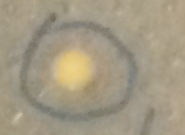Bacillus marisflavi is a gram-positive motile bacteria that was previously isolated by Yoon and colleagues (2003) from the sea water of a tidal flat of the Yellow Sea in Korea.
References
- Yoon JH, Kim IG, Kang KH, Oh TK, Park YH. 2003. Bacillus marisflavi sp. nov. and Bacillus aquimaris sp. nov., isolated from sea water of a tidal flat of the Yellow Sea in Korea. International journal of systematic and evolutionary microbiology. 53(5):1297-303.
Date collected: December 12, 2016
Methods for isolation and identification:
- Five milliliters of surface water was collected from the surface of a retention pond in Lancer Park (Figure 1). A sterile swab was mixed in the water and spread across a sterile LB agar plate. The plate was incubated at 37 degrees Celsius for 16 hours.
- A light yellow colony (Figure 2) was selected for 16S rRNA gene sequencing by PCR amplification.
- The PCR product was digested with MspI and sequenced to identify the genus and species of the bacteria.
 Figure 1. Site of collection
Figure 1. Site of collection

Figure 2. Colony selected for identification
Results:
- MspI digestion (Figure 3): A 1,500 bp product was amplified by PCR. Upon digestion with MspI, four bands at approximately 650 bp, 400 bp, 225 bp, and 175 bp were identified.

Figure 3. Results of PCR amplification and MspI digestion
- Sequence analysis (Figure 4): The sequenced PCR product generated 857 bases of high-quality reads that were used to identify the genus and species of the colony. The chromatogram of the sequence is available as a pdf (rDNA_seq_1_PREMIX_KG2496_1). NCBI BLAST analysis revealed 99% identity with bases 35-891 of the 16s rRNA gene of Bacillus marisflavii (Figure 4).
 Figure 4. NCBI BLAST analysis of colony 16-1
Figure 4. NCBI BLAST analysis of colony 16-1
Contributed by: Erin K. Shanle, BIOL 250 Spring 2017, Group 16